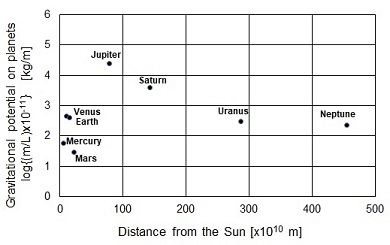Chap.3 How Planets were Formed

3.1 Accretion of interstellar matter
In the current solar system, the mass of the sun is 99.86%, and the total
mass of planets is about 0.14% of the solar system. Most of the material
in the solar system was gathered on the Sun by the gravity of the heliocentric,
but the remaining 0.14 % of matter orbits in the heliocentric gravitation.
In the strong heliocentric gravitational field, the orbiting materials
exists only in the orbit determined by Kepler's third law ; (r3/T2)=G(m+M)/(4π2). Here M is the mass of the Sun, and m is the mass of matter orbiting.
Since M is very large compared with m, matter in the orbit in the gravitational
field at the center of the Sun has extremely little influence on the magnitude
of the mass (m) and orbits at about the same speed. Materials of various
sizes continue to orbit the same orbit.
There, solid substances orbiting at the same speed come into silent contact.
At the contact point between solids in slow contact, they adhere to the
Coulomb force and become lumps. The enlarged mass also orbits in the same
orbit. Therefore, about 0.14% of the cosmic dust in the proto-solar system became
a lump in each orbit, the lumps beccame a planetesimal and plnetesimals
became asteroid, and planet.
So, the planets currently orbiting have the characteristics of the distribution of the interstellar medium in the solar system.
3.2 Distribution of interstellar matter in solar system
The relationship between the distribution of the density of the primordial
interstellar medium with respect to the distance from the Sun is estimated
from the mass (m planet) and position (LSun-planet). Set the value of the infinity point to 0, and when the planet moves from the sun to its current position, the change in the potential due to the gravity of the sun is the gravitational potential energy of the planet.
According to Newton's mechanics, the gravitational potential energy of
a planet is inversely proportion to its distance from the center of mass
(LSun-planet).
The value of potential energy (Φplanet) obtained by collecting the interstellar medium in the surrounding area of the planet
is proportional to the m planet of the planet as shown in Eq.(4), (Φplanet) isinversely proportional to LSun-planet. Fig.7 shows the common logarithm of the value of (mplanet/LSun-planet) for each planet in the solar system using the distance from the Sun as the horizontal axis.
Φplanet=-mplanet・(G・MSun)/(LSun-planet)=-G・MSun・(mplanet/LSun-planet) (4)
Fig.7 shows the gravitational potential collected by the planets of the solar system. For the exoplanets Jupiter, Saturn, and Uranus, the value of (m planet /L Sun-planet) is decreasing exponentially with respect to its distance from the Sun.
This indicates that giant gas planets grew in the state where the density distribution of the
proto stellar medium is distributed exponentially with respect to the distance
from the Sun.
Jupiter has a magnetic field about 20,000 times stronger than the Earth,
and the ions of the solar wind are wrapped around the magnetic flux and
taken into the planet, so its mass is increasing.
 Fig.7: The gravitational potential of the Sun on planets.
Fig.7: The gravitational potential of the Sun on planets.
Note that the (m/L) value of Neptune, which is more than 4 billion km away from the Sun, does not hold the exponential rule. On the other hand, since terrestrial rocky planets approach the Sun, the exponential rule does not hold for rocky planets. (last
modified Feb/28, 2023)
to Index -3.1-